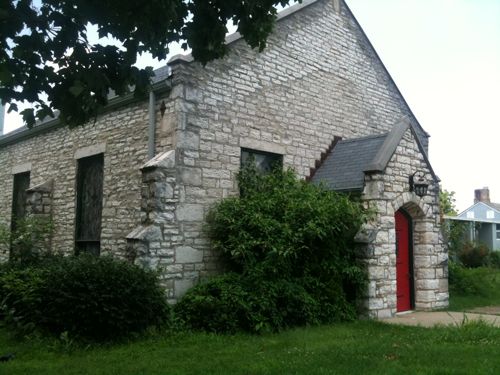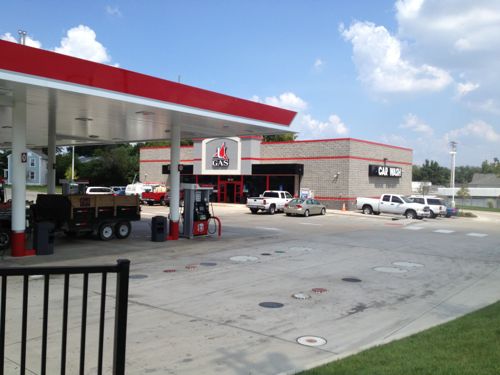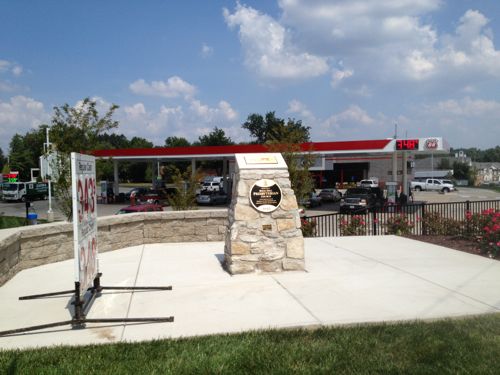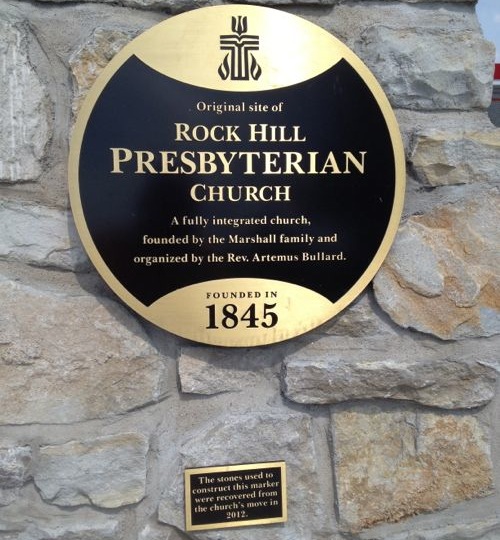Gas Station Replaced Rock Hill Church Built By Slaves
For more than a century a modest stone church stood in what later became the City of Rock Hill. Built by slaves in the 19th century, it couldn’t compete with a gas station + convenience store in the 21st century.




I’ve been told the church was “fully integrated” because the Marshall family required their slaves to attend the church they built. A little feel-good revisionist history?
There’s nothing to feel good about on this site. This is now a sprawl corner like thousands of others in St. Louis County. What once made a positive contribution to the sidewalk experience has been reduced to a monument few will read as that would require exiting their car and actually walking a bit.
— Steve Patterson
Every time I read about this story, it sickens me all over again. This is how this important piece of American history ended up (Courtesy of Chris Naffziger):
http://stlouispatina.com/rock-hill-presbyterian-slightly-disassembled/
“Fully integrated”. I want to vomit. The Presbyterian church should be ashamed of themselves.
If there’s anyone to blame it would be the (lack of) parishioners at this location. If the church were truly active, with a large and active congregation, there would have been no reason to sell. The city (not just Rock Hill) is dotted with old churches that have few real users and even fewer viable new uses. If this were a typewriter store or a telegraph office, should it have been “saved”, even if it were empty and unused, just because it’s “old” and has “a lot of memories” (for some people)?! Churches, whether you want to admit it or not, are “in business”. They need to attract customers to pay their bills and their ministers, and some are more successful than others and, yes, some fail. We simply can’t keep the shell of every failed business, religious or secular, just because of the good memories or the goodness of its architecture. If it can be reused, sure do it. But to just let it sit, vacant, for decades, no. We don’t live in a museum, we live in an ever-changing world . . . . http://www.loopnet.com/Missouri_Churches-For-Sale/
If you want to live in a soulless, empty wasteland with no character, by all means do it. But don’t destroy other people’s right to live in a community with actual soul. And please do us all a favor and don’t come down to the city to have pictures taken in front of all of St. Louis’s amazing buildings. Go to a strip mall parking lot, since that is what St. Louis County’s contribution to civilization is.
I have no desire “to live in a soulless, empty wasteland with no character”. So explain to me how we can “prevent this from happening”, short of just saying no to every demolition permit application and every building permit application?! Gas stations, especially the currently-favored, multi-island, mini-mart model, suck – I agree. This was a quaint, old church – I agree. But both the gas station business model and the church business model have changed and (d?)evolved over the past 50-100 years – even the St. Louis Catholic diocese has been closing and selling churches and schools due to declining demand and rising costs. Small and quaint ain’t cutting it anymore, we “need” the mega church – http://faithchurch.com/?gclid=CPrombClyLkCFfFj7AodZTgAlQ – and the mega mart with the drive-thru quickie car wash.
We have two choices. We can abandon and board up the old stuff in the city and the inner-ring suburbs, building all the new/desired stuff/crap out on the fringes, in the new suburbs OR we can tear down and replace what “ain’t workin’ no more” in the city and the inner-ring suburbs and replace it with the new/desired stuff/crap, hopefully in a slightly more “urban” form! Yes, the tradeoff here was stark, but the city of Rock Hill did not use eminent domain and condemn the church complex, the church sold their property on the open market for a fair price to a willing buyer who made it clear that they had no use for the existing structures – they had a choice and they made a choice! If “we” wanted to “save” this structure, then “we” should have come up with a better offer – we can’t always expect to tell “them” what “they” can or cannot do with their property just because we like it the way it is/was or because we know better!
Buildings need to be used, not just left sitting vacant. And no, it’s not the government’s responsibility to buy up every significant old building in the city or the county that “should be saved”. Private historic groups can do some of that, just like individual buyers can (and do). But there will (should?) always be change, and hopefully for the better. Will significant structures be lost? Absolutely! But just because what will replace something may not meet your or my perception of “better” should and does not disqualify it from happening. Just say no is rarely the best answer, we need to reinvest in our city and our region, otherwise we’ll end up looking like parts of north city and East St. Louis and we’ll condemn ourselves to decades of urban blight and still lose many of the structures we’re hoping to “save”. . . .
Rockhill is a suburban shot bag, nothing like the city, don’t lump it in with the city. Rockhill is more like west county (it is west county) than its like the city.
Why so tough on Rock Hill? You may not like it, I may not like it, but enough people do to keep it a functioning and housing stock maintained. They also may have their issues, but they aren’t known to brush them under the carpet and claim they are paradise like some further west communities. They acknowledge that they are flawed and that at least gives them a step up. Besides WE know that the only paradise is the City.
this is URBAN review stl, not SUBurban review. there is nothing urban about rock hill, its not germane to the topic of this blog. Its not that I dont like cock hill, I dont CARE about it. Its meaningless to those trying to create a functioning urban community here. its not just a city/county thing, places like ucity, clayton (gag me) and maplehood (gag me harder) should be considered, not rockhill. I hae clayton and maplehood, but they are built in a somewhat urban way and are close to the urban core, so even though i dont like them, i realize they must be in the conversation. but rockhill? BLAHHHHHHHHH
So a line on the map creates an absolute demarcation between “urban” and “suburban”? I hate to burst your bubble, but much of the city IS suburban in scale (pretty much anything south of I-44 or north of Delmar) and, unfortunately, approaching rural (in some areas). I’ll repeat my question – how we can “prevent this from happening”, short of just saying no to every demolition permit application and every building permit application?! The people who actually live in the “suburban” parts of the city don’t seem very inclined to support more density, and certainly not “real” urban densities. They actually seem to like the new U Gas on Hampton and Steve’s favorite, Loughborough Commons. Yes, U Gas would be highly inappropriate downtown, in the CWE or in Soulard. But, in many, many other areas, it would (and is) both appropriate and welcomed. We don’t live in a one-size-fits-all, high-density urban paradise, we live in a diverse city that supports many density levels, many visions and many answers to what the built environment can and should be. So I guess the real question becomes does the “urban” or does the “STL” take precedence in this blog? Steve obviously wants to look at issues on a regional scale (as do I), not just confine himself (or the blog) to the CWE, Grand Center, Washington Avenue and Soulard!
Nice reading comp, I guess you missed the county towns I mentioned that are relevant (rosk hill ain’t one of them). South of 44 my ass. I guess tower grove east/south, cherokee and benton park aren’t urban either? The most dense parts of the city are SOUTH of 44, tge, bpw, dutchtown. If the blog wants to be urban, and its in the name, its should focus on the city (its ok to exclude parts that are just like the county, like stl hills), and a couple select inner ring county towns. Go back to denver, or the county, its all the same to me.
And to assist your reading comprehension, I’ll repeat, does the “urban” or does the “STL” take precedence in this blog? St Louis, both the city and the region, includes both more-dense and less-dense areas. Ideally all would become, incrementally, more dense. Sure, it’s easy dis and ignore all the areas that don’t fit your ideal paradigm, as beneath your contempt, but that won’t make them magically disappear, nor will it do much to move them closer to your ideal.
Urban means city. Stl means st louis (not rock hill). Ill take both
“This site takes a close look at the planning, policies and politics of the St. Louis region.” http://www.urbanreviewstl.com/about/
As a resident of Dutchtown, I live in the Gravois-Jefferson Streetcar Suburb National Historic District. Soooo…
You mean, like when they built all the tall buildings downtown? Even the Wainwrght building replaced something else.
I find it rather disheartening that monetary considerations still trump the lessons of history and historical place in American culture. While I am more than cognizant of the current pathologically sick nature of American society, and its relation to the aggressively predatory nature of American ‘capitalism’, it yet brings me no comfort to see this historic site reduced to a pointless, needless commercial use, and the structure which once stood here reduced to nothing more than a pile of rubble.
I am certain that the Presbyterian Church has the viewpoint that the resources available to them should be prioritized in the care of human beings, and not on the material life of a structure dedicated to worship. Indeed, it is a laudable and noble goal, and should then not be open to criticism. But when the goals of teaching the words of the Christ figure and observing the history of our country converge–especially when the subject of the immoral institution of slavery are concerned–it would seem obviously incumbent upon the caretakers of this site to take advantage of its role not only in the Church, but its role in the life and culture of our Nation. A tremendous opportunity for spiritual growth and historical education is squandered on commercial gain.
There are many groups to blame but the bottom line, even if we don’t like it, is that not every building can be saved. Numerous groups over the years have tried but failed.
And I’m willing to bet that many that were against the demolition will be using that gas station.
I don’t have a problem with razing the old church, my problem is what replaced it. Is that really the best we can do? But I suppose a gas station is appropriate since people worship their cars.
Its rockhill, it was built for cars, let them have their damn cars. Save your outrage for when they do this stuff in the city
Rock Hill was named that because of the Rock Church on the hill, by 1934 it was incorporated as a village. http://www.rockhillmo.net/History.aspx
It could have been named anything, but the bottom line is that the residents didn’t think it important enough and the gas station serves a better purpose. And like it or not, they have that right to have that, not for “outsiders’ to come in and dictate otherwise. Do I think they lost a bit of identity? Sure do. But even if they were rolled into the County (with all the other mom and pop towns), that’s no guarantee the results would be any different.
But you would think that some Presb or some other religious group could have found a spare lot or a few parking spaces to give up to host the building and some others to get the money to move it. I mean if we can waste millions for Archibald’s (History Museum) lot, you would think we could spare a few dollars for this.
for what it is worth, the new gas station/convenience store appears
to have quite a lot of busines. And a few blocks west, there is an old
gas station now closed and another old one with little business,